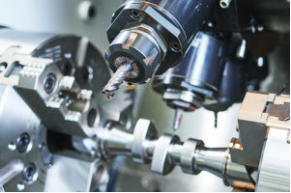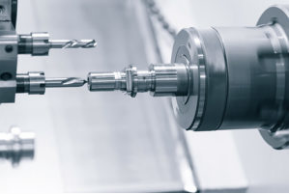Hotest Articles

It goes without saying that achieving a high-quality finish with CNC machining is of critical importance. This is especially so for end-use parts and mold-making components. Manufacturing clients greatly sought after CNC machining as a robust rapid manufacturing solution. This is due to its ability to produce parts with very tight tolerances.
However, milled and machined metal or plastic components that are milled and machined do not always have smooth finishes. This wouldn’t be a problem. But these materials require the finishes for certain end-use or molding applications.
To address this, there are a number of post-processing techniques to give CNC machined parts the desired professional finish. This makes machining surface finish very vital. Moreover, high surface quality is a top priority for your products. You need some to ensure that even your as-milled component is the best it can be. We will provide you with all the necessary information you need.
Why is Machining Surface Finish Important for CNC Machined Parts?
Surface finishes are not only for aesthetic purposes. Instead, they serve many other important purposes.

Some of the benefits of CNC machining finishes include the following:
1. It increases the corrosion resistance of the metal
Corrosion is a significant destroyer of metal parts and their surfaces. Rusts on metal surfaces reduce the quality of such components, and they won’t be able to perform their functions adequately. Most of the metal machined surface finish examples target corrosion resistance. A correctly done machining surface finish ensures adequate protection of the metal. Therefore, you can be sure that it will last longer.
2. It enhances the aesthetics of the metal
Some clients place aesthetics as highly as the performance of the product. This is because the appearance of your product says a lot about it. With the various metal surface finishes available, your CNC machined parts will look as good as they can.
3. It eases the manufacturing process
A properly done machining surface finish will make manufacturing much easier. For example, a sandpapered or brushed surface adheres better to paints. This helps to relieve the manufacturer’s stress.
Generally, surface finishes on CNC machined parts:
Improves metal conductivity;
Increases wear resistance;
Minimizes friction effects on the metal;
Increases the strength of the materials;
Protects the metal from chemical attacks;
Improves the rust-resistant properties of the metal.
Knowing What CNC Machining Surface Finish You Need
When working with CNC Machining, professional services such as GUAN SHENG offer a range of surface finishes. These finishes aim to meet the requirements of various applications. Regardless of the type of product you order, your prototype, mold, or end-use component will come with the best finishes. Below are some of the machined surface finish examples offered by GUAN SHENG for CNC machined components.
1. As-Milled
An as-milled CNC machining surface finish does not require any post-processing. It simply indicates the part will remain in its machined state as CNC machining is able to manufacture parts with tight tolerances of up to ± 0.025 mm. As-milled components usually result in the best dimensional precision.

It should be noted, however, that as-milled parts will be dull. They may also still show tool marks on their surface and thus will not be perfectly smooth. The average surface roughness (Ra) of an as-milled part is about 3.2 μm. However, additional smoothing and polishing can reduce the machined texture.
Without smoothing or polishing, an as-milled standard machining surface finish should not incur any additional production costs. Therefore, it is the most cost-effective machining surface finish solution available. An as-milled finish is most suitable for prototypes and jigs and fixtures.
2. Bead Blasting
Bead blasting consists of shooting small spherical media at the surface of a CNC machined part using compressed air. These media may be glass beads or similar materials. The result of bead blasting is typically a uniformly smooth texture with either a matte or satin finish.

This process relies on using small beads to remove incremental amounts of material from the machined part’s surface. Thus, it is possible that the post-process can affect the dimensional accuracy of the part. This might, however, be a very slight effect. Bead blasting is primarily used for aesthetic applications and on products that require good visual qualities.
3. Powder coating
The powder coating process involves applying a thin layer of dry polymer powder to the machined part. This method adds strength and wear-resistance to the CNC machined metal. Manufacturers apply various layers of powder coating to parts to increase stability. However, this might affect the dimensional tolerances of the finished component.

Powder coating is compatible with all machining metals. It also enables users to choose from a wide variety of color finishes. Many manufacturers also combine this post-process with bead blasting for a superior smooth finish. It is ideal for end-use products.
4. Anodizing (Type II and III)
As a post-process, anodizing adds a very thin ceramic layer to the surface of metal machined parts. This process imparts corrosion and wear-resistant properties. The anodic coating applied during the electrochemical post-process is also non-conductive. This means it is important to mask elements of the part during anodization if conductivity is required.

There are two major kinds of anodizing used for custom CNC machined parts. The first one is Anodizing Type II. Here, you have a standard anodizing process. It helps to produce coatings that are uniform and rust-resistant. With this type, you can dye your parts in several different colors. Manufacturers often refer to it as ‘decorative anodizing.’
The second type of anodizing is type III. This is often referred to as Hardcoat Anodizing. Using this type gives the metal thick ceramic coatings. This way, you can be sure of a high-density component with excellent corrosion and wear resistance.
The main advantages of anodizing CNC machined parts are high aesthetic quality. The dye can impart different colors and durability. In terms of applications, anodizing is primarily useful for engineering parts. When considering anodizing for your product, you should also note that it is only applicable for parts made from aluminum or titanium.
5. Passivation
Passivation is a chemical process involving several processes. This CNC machining surface finish improves the corrosion resistance of metal parts. If there are any passive layers on the metal surface, this method helps to enhance their chemistry.

There various kinds of passivation include the following:
Tank Immersion – This process helps in creating uniformity of finish on CNC machined metal surfaces. This way, it imparts corrosion and wear resistance on the metal.
Application of Spray – This is the best method of on-site metal treatment. It involves the use of a special type of spray to enhance the chemistry of a passive layer.
Circulation – It involves circulating chemical solutions through systems of pipework.
Application of Gel – This manual treatment involves brushing gels onto the surfaces of these metals. It is the best method for treating welding spots and other intricate areas on the metal.
General Rule of Thumb for CNC Machining Surface Finish
Some basic tips can guide you in choosing the CNC finishing for your product. It is not compulsory to follow them to the letter.

However, the rule of thumb stems from our manufacturing experience. They are:
As-milled finishes are best used for parts with tight tolerances. They are most useful when aesthetics is not the major concern.
Bead blasting is best for parts with matter uniform finishes. In this case, maintain dimensional tolerances is not the key issue.
Anodizing Type II will add a thin protective layer to titanium and aluminum parts. This protective layer is also aesthetically pleasing.
Use anodizing Type III for metals for engineering applications. The metals, in this case, require very high surface hardness and wear resistance.
Powder coating will come in handy when you need high-impact strength or when you want to finish parts that do not support anodizing.
Factors to Consider When Choosing a CNC Machining Surface Finish
CNC finishing is a key post-process method that essentially determines the look, feels, and function of a part. It is essential to know you can choose the best finish for your part. Here are some of the factors to consider to make sure you choose the right one from the start:
1. The Product’s Application
Different parts are subjected to different environmental conditions, be it vibrations, heat, moisture, UV light, etc. A careful consideration of who and what the product is for will help you make the right choice. Metals intended for outdoor use and increased exposure need a standard machining surface finish that improves their hardness. The chosen finish should also increase the wear and metal resistance. Parts used in construction will place less focus on aesthetics. Durability is often the major concern in this case.
2. Durability Concerns
You need to ask yourself how long you want your product to last. Durability is a major part of manufacturing. Although the raw material plays a crucial role here, you cannot leave out the machining surface finish. Adding value to your finished product involves durability, and you should choose the right finish for that.
3. Relationship Between the Raw Material and the Metal Surface Finish
Some materials are hard to polish. It may be challenging to anodize some other surfaces, while paint may not stick well to certain materials. Therefore, you must consider CNC finishing from the beginning of the design process. Do not wait till the last minute to decide the surface finish for your CNC machined part. Research to ensure that your surface finish matches the raw materials involved.
4. The Part’s Dimensions
One important point to note is that the machining surface finish may change a part’s dimensions. Thick finishes such as powder coating may increase the surface thickness of the metal material. Coatings may also affect the mating surfaces and clearances of parts that must fit. Finishes that use chemicals may eat away a tiny degree of the material and slightly affect dimensions. You must calculate these factors at the beginning of the project to ensure quality production.
5. Cost
Having considered the above-listed factors, you should then consider your budget for the project. The best finishes often need careful preparations and complex procedures. They also require the use of higher-quality materials. All of these are cost drivers when it comes to manufacturing. So, you need to consider these and compare them with your budget before choosing a machining surface finish.
Conclusion
CNC machined metal surface finishes offer several benefits for your finished parts. There are many finishing options available, and each offers unique advantages. This guide provides you adequate information on the best CNC machining surface finish. It also discusses several factors to consider before choosing your preferred surface finish.
Manufacturing experts are always your best bet when deciding on a metal surface finish. GUAN SHENG is the best company to go to for expert services and advice. Our experts at GUAN SHENG are highly knowledgeable in everything about manufacturing, including surface finishing. We are ready to take your product to the next level, from product design to prototyping and large-scale manufacturing.
Our team will help you choose the best finishes for your CNC machined part. We make sure you take a strong, durable, and elegant finished product to the market. All you have to do is contact us today, and let’s talk about first-class rapid prototyping.






